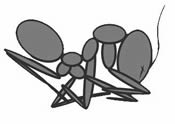Grey Portraits
Initial Trials
I was given 5 litres of old white interior house paint that had 'gone off' and some warped MDF board. I mixed the paint with cheap interior black paint at varying ratios to make greys. (In keeping with the street art DIY ethos, each portrait costs between $5-10).
Art is often surrounded by mysticism; it’s common for people to ascribe refined painting ability to a divine gift. In reality, portraiture is just a skill set like anything else. With thought and application, anyone can develop any skill set. I had never taken an art class before or picked up a brush. I just thought about how to paint an image, picked up a brush, tried and these were the results.
Attempt 01
90 mins painting time.

Attempt 2
Approx 120 mins painting time

Each successive attempt far exceeded my expectations. Painting is far easier than most artists would have you believe.
Attempt 3
Approx 3.5 hrs painting time

(This portrait was removed about 3 days after installation. No idea if it's in someone's home or rotting in a landfill).
Attempt 4

The white crap around the edges is silicon glue. I used to hold the portraits up with support struts while the glue dried. One night the struts slipped, then there was a loud crash, then there was a louder profanity that echoed through the empty city in the early hours of the morning. The next day I bought a hammerdrill, and screwed into the wall to hang the portrait on wire while the glue dried.

Residue
Street art can be used to narrate forgotten history about the environment it inhabits and the people who once inhabited it.
Pemulwuy

Pemulwuy was an Aboriginal man who resisted European settlement in the Botany Bay area.
After Pemulwuy was killed, he was decapitated and his head sent back to England for study. A letter from Governor King accompanied the head which contained this sentiment "...although a terrible pest to the colony, he was a brave and independent character...". Many street artists and other rogues I know would be quite happy with this epitaph.

Jeffries:Brady:Batman
Free hand aerosol and brush.

Matthew Brady was a convict escapee bushranger in colonial Tasmania. As a fugitive, robbing settlers was necessary for survival but Brady is famous for never robbing or insulting women and conducting himself with good manners during a robbery. He was hence dubbed the 'gentleman bushranger'. The flowers brought to him by the woman of Launceston prior to his execution testify to his popularity in the colony.
Mark Jeffries was also an escaped convict, who ran with Brady for a time but was expelled for being a 'dehumanized monster' after molesting women during a robbery. Jeffries escaped the convict settlement twice, both times taking other convicts with him whom he would later cannibalize. While imprisoned Jeffries acted as a scrouger, executioner and informed on other escaped convicts.
On the 4th May 1826, Jeffries and Brady were both hanged at old Hobart jail. Brady reputedly protested bitterly at being hanged in such poor company.
Brady and Jeffries speak to the dichotomy of man: Separated from civilization and hunted in the brutal wilderness of colonial Tasmania, one man chooses to embrace moral conduct and his humanity while the other completely discards it.
Intertwined into the story is the Father of Melbourne: John Batman. Prior to becoming a pastoralist and explorer Batman was a bounty hunter who captured Brady and hunted Jeffries. Between these two mythologized archetypes lie ourselves and we might wonder: faced with the bleak reality of death by starvation how might we conduct ourselves?



You Jason?
As a teenager during the late 90s, I remember walking down Bourke st in Melbourne. A guy comes up to me.
Guy: “Hey kid, are you Jason?”
Me: “No. My name is Chris.”
The guy smiles and walks on. I’m confused. Shortly after, another guy approaches me.
Guy 2: “You Jason?”
Me: “No. Do I look like him or something?”
This guy laughs and also keeps walking. A third guy comes up soon after.
Guy 3: “Hey man, you Jason?”
Me: “I don’t get it. Who’s this guy Jason anyway?”
It wasn’t until later that I realised they were actually asking “Are you chasin’?” People used to slur it together, so it sounded like Jason. I know this was a pretty common experience for a lot of people and it’s an old joke in heroin culture. It’s commonly forgotten that the corner of Bourke st and Russell st used to be the epicentre of the heroin street trade in Melbourne. A social worker I know told me that Donaldson ln, next to the Hoyts cinema on Russell st, was the leading location for overdoses. A small needle disposal box at the end of the laneway now stands as a rudimentary cenotaph to the people lost there and the loss of the memory of those people. This is an aspect of our shared urban history that is welcomely forgotten because it’s ugly and distressing. Like averting our eyes from the homeless, it’s comfortable to deny the existence of undesirables. Whether we choose to acknowledge it or not, bodies really came out of those laneways. People really died. The problem continues, hidden. And the obligation on the artist is to truth, not prettiness.
On the 15th Jan, I installed this work without solicitation. Hoyts, the owners of the wall objected and the City of Melbourne Council prioritised it for rapid removal.



